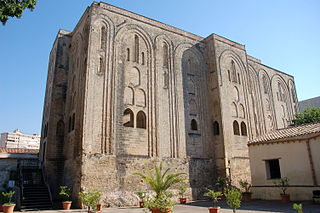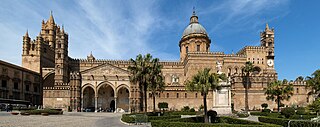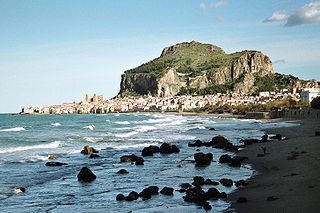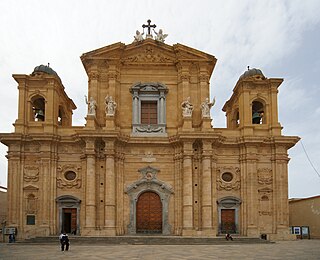
Palermo is a city in southern Italy, the capital of both the autonomous region of Sicily and the Metropolitan City of Palermo, the city's surrounding metropolitan province. The city is noted for its history, culture, architecture and gastronomy, playing an important role throughout much of its existence; it is over 2,700 years old. Palermo is in the northwest of the island of Sicily, by the Gulf of Palermo in the Tyrrhenian Sea.

Monreale is a town and comune in the Metropolitan City of Palermo, in Sicily, southern Italy. It is located on the slope of Monte Caputo, overlooking the very fertile valley called "La Conca d'oro", a production area of orange, olive and almond trees, the produce of which is exported in large quantities. The town, which has a population of approximately 39,000, is about 7 kilometres inland (south) of Palermo, the regional capital.

The term Norman architecture is used to categorise styles of Romanesque architecture developed by the Normans in the various lands under their dominion or influence in the 11th and 12th centuries. In particular the term is traditionally used for English Romanesque architecture. The Normans introduced large numbers of castles and fortifications including Norman keeps, and at the same time monasteries, abbeys, churches and cathedrals, in a style characterised by the usual Romanesque rounded arches and especially massive proportions compared to other regional variations of the style.

The Church of San Cataldo is a Catholic church located at Piazza Bellini, in central Palermo, Sicily, Italy. Erected in 1154 as a notable example of the Arab-Norman architecture which flourished in Sicily under Norman rule on the island, the church is annexed to that of Santa Maria dell'Ammiraglio. Since the 1930s, it belongs to the Order of the Holy Sepulchre.

The Cuba is a recreational palace in the Sicilian city of Palermo, originally part of the Sollazzi Regi group of Norman palaces. It was built in 1180 by William II of Sicily in his Royal Park, together with an artificial lake. The name Cuba derives either from its cubical form, or the Arabic Qubba, "dome". It is an imitation of the Zisa palace. In July 2015 it was included in the UNESCO Arab-Norman Palermo and the Cathedral Churches of Cefalù and Monreale World Heritage Site.

Monreale Cathedral is a Catholic church in Monreale, Metropolitan City of Palermo, Sicily, southern Italy. One of the greatest existent examples of Norman architecture, it was begun in 1174 by William II of Sicily. In 1182 the church, dedicated to the Nativity of the Virgin Mary, was, by a bull of Pope Lucius III, elevated to the rank of a metropolitan cathedral as the seat of the diocese of Monreale, which was elevated to the Archdiocese of Monreale in 1183. Since 2015 it has been part of the Arab-Norman Palermo and the Cathedral Churches of Cefalù and Monreale UNESCO World Heritage Site.

Nicosia is a comune (municipality) in the province of Enna, in the Italian region of Sicily. It is located at 720 metres above the sea level, on a rocky massive culminating in four imposing hills. The origin of Nicosia is uncertain. Nicosia and Troina are the northernmost towns in the province of Enna. The vicinity was traditionally made up of salt mines and arable lands.

Palermo Cathedral is the cathedral church of the Roman Catholic Archdiocese of Palermo, located in Palermo, Sicily, southern Italy. It is dedicated to the Assumption of the Virgin Mary. As an architectural complex, it is characterized by the presence of different styles, due to a long history of additions, alterations and restorations, the last of which occurred in the 18th century.

Castronovo di Sicilia is a comune (municipality) in the Metropolitan City of Palermo in the Italian region Sicily, located about 50 kilometres (31 mi) southeast of Palermo.

San Giovanni degli Eremiti is an ancient former monastic church located on Via Benedettini #19 in the ancient quarter of Albergaria of the city of Palermo, region of Sicily, Italy. It is about two blocks south from the Palazzo dei Normanni, adjacent to the church of San Giorgio in Kemonia. While the interior is virtually devoid of decoration or furnishings, the red Norman-Byzantine domes, the medieval cloister ruins, and garden make this small church a symbol of ancient Palermo.

The term Norman–Arab–Byzantine culture, Norman–Sicilian culture or, less inclusively, Norman–Arab culture, refers to the interaction of the Norman, Byzantine Greek, Latin, and Arab cultures following the Norman conquest of the former Emirate of Sicily and North Africa from 1061 to around 1250. The civilization resulted from numerous exchanges in the cultural and scientific fields, based on the tolerance shown by the Normans towards the Latin- and Greek-speaking Christian populations and the former Arab Muslim settlers. As a result, Sicily under the Normans became a crossroad for the interaction between the Norman and Latin Catholic, Byzantine–Orthodox, and Arab–Islamic cultures.

The County of Sicily, also known as County of Sicily and Calabria, was a Norman state comprising the islands of Sicily and Malta and part of Calabria from 1071 until 1130. The county began to form during the Christian reconquest of Sicily (1061–91) from the Muslim Emirate, established by conquest in 965. The county is thus a transitional period in the history of Sicily. After the Muslims had been defeated and either forced out or incorporated into the Norman military, a further period of transition took place for the county and the Sicilians.

Cefalù, classically known as Cephaloedium, is a city and comune in the Italian Metropolitan City of Palermo, located on the Tyrrhenian coast of Sicily about 70 km (43 mi) east of the provincial capital and 185 km (115 mi) west of Messina. The town, with its population of just under 14,000, is one of the major tourist attractions in the region. Despite its size, every year it attracts millions of tourists from all parts of Sicily, and also from all over Italy and Europe. It is one of I Borghi più belli d'Italia.

The County of Apulia and Calabria, later the Duchy of Apulia and Calabria, was a Norman state founded by William of Hauteville in 1043 composed of the territories of Gargano, Capitanata, Apulia, Vulture, and most of Campania. It became a duchy when Robert Guiscard was raised to the rank of duke by Pope Nicholas II in 1059.

Arab-Norman Palermo and the Cathedral Churches of Cefalù and Monreale is a series of nine religious and civic structures located on the northern coast of Sicily dating from the era of the Norman Kingdom of Sicily (1130-1194): two palaces, three churches, a cathedral, and a bridge in Palermo, as well as the cathedrals of Cefalù and Monreale. They have been designated together as a UNESCO World Heritage Site. This dedication took place in 2015.

Notarbartolo is one of the main aristocratic families of the Sicilian nobility. Originated in the Middle Ages, it gave to the island numerous personalities who have made a significant contribution to its social, political, intellectual and artistic life. The different branches of the family collected, over the centuries, numerous fiefdoms and noble titles.

Palermo, main city of Sicily, has a big heritage of churches which ranges from the Arab-Norman-Byzantine style to the Gothic and the Baroque styles. In particular, the list includes the most important churches of the historic centre divided by the four areas of Kalsa, Albergaria, Seralcadi and Loggia.

The Maredolce Castle, also called Favara Palace, is a medieval building of Palermo. During the Siculo-Norman age it represented one of the "Solatii Regii", pleasure palaces, of the Kings of Sicily. It is located within Favara Park, in the neighbourhood of Brancaccio.

The following outline is provided as an overview of and topical guide to Palermo:

Marsala Cathedral is the largest church in the town of Marsala, Sicily, and the Diocese of Mazara del Vallo. Its facade faces onto piazza della Repubblica and the nearby via Giuseppe Garibaldi. It is dedicated to the Anglo-Norman saint Thomas Becket, whose cult was introduced to Sicily via its close relations with England under William I and William II – the latter even married Henry II of England's daughter Joan, who also supported Thomas' cult despite Henry's part in triggering his death.































